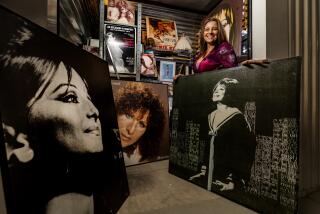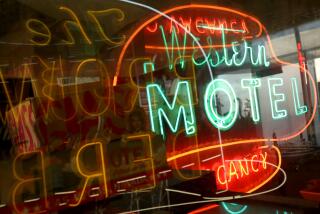Pomona Man Wrote the Book on Pepsi Merchandise
- Share via
POMONA — Bob Stoddard is a member of the Pepsi Generation. He caught the Pepsi Spirit. He met the Pepsi Challenge.
You might say he wrote the book on Pepsi. Really.
Stoddard, a 40-year-old paper salesman who drinks a six-pack of Pepsi-Cola every day, has just published, at his own expense, “Introduction to Pepsi Collecting,” which contains a history of Pepsi-Cola dating to its creation in 1898. The book includes pictures and estimated prices of Pepsi signs, bottles, toys and other items.
He plans to sell the volume for considerably more than the price of a can of cola: $19.95.
Not surprisingly, in addition to his publishing exploits, Stoddard’s Pomona house and garage are full of Pepsi memorabilia.
Items in Stoddard’s collection include a 1909 tray that features an early Pepsi-Cola logo, a 1931 metal sign that shows a curved Pepsi bottle that the company had to withdraw because of its similarity to Coke bottles, and a 1947 Pepsi bottle radio that is about two feet tall and incorporates the radio dial in the bottle cap.
Stoddard said one of the hallmarks of a Pepsi collector is a thirst for the soft drink itself. Stoddard, who grew up in Southern California, said he became a Pepsiholic in 1972 when a Pepsi vending machine at an Army base in Virginia offered the only relief he could find from the humidity.
After leaving the Army, Stoddard kept drinking Pepsi and bought a Pepsi cooler to keep a supply on hand. That was the beginning of a Pepsi collection that has grown to more than 2,000 items, including toy trucks, thermometers, signs, trays, napkin holders, clocks and boxes, all with Pepsi logos.
“There are two kinds of people in the world,” Stoddard said. “Those who collect things and those who throw things away.”
Influenced by his grandfather, who was an antiques dealer, Stoddard is definitely not one to throw things away.
Stoddard said he began amassing memorabilia a dozen years ago, meeting other Pepsi collectors in the process. He organized the Pepsi-Cola Collectors Club eight years ago. The club, which has 1,500 members throughout the United States and Canada, publishes a newsletter six times a year and stages an annual Pepsi-Fest in Indianapolis.
His store of Pepsi lore is so extensive that Pepsi invited him to display his collection at the opening of a regional Pepsi headquarters in Pittsburgh, and the company hired him as a consultant to obtain Pepsi items from the 1940s and 1950s for display in Mel’s Diner at Universal Studios.
Andrew Giangola, a spokesman at Pepsi-Cola headquarters in New York, was not familiar with Stoddard, but said the company is delighted that people are collecting Pepsi items. “We think it’s great,” he said. “It’s flattering to have people devoting so much energy to preserving your place in Americana.”
Giangola said the company catered to collectors last year by putting out limited-edition, seasonal Pepsi cans and glasses that depicted such things as sunglasses in summer and snowmen in winter.
Stoddard said Pepsi collections are particularly popular with members of the baby boom generation, who were influenced by the Pepsi Generation ad campaigns of the 1960s.
Just as Pepsi-Cola never quite overtook Coca-Cola in soft drink sales, its memorabilia hasn’t surpassed Coke memorabilia in value, either. But Stoddard said prices of Pepsi items have risen rapidly in recent years. The most expensive item he has seen, he said, is a 1909 ceramic Pepsi dispenser worth $6,000.
His collection is now so big that he has little room for more. But he continues to comb swap meets and antique stores looking for Pepsi rarities.
Even though Stoddard can almost instantly date any Pepsi item by subtle differences in the style of the logo, the shape of the bottle and other clues, he said he is still learning Pepsi lore. The excitement of collecting, he said, is finding something you’ve never seen before. “It’s like a treasure hunt,” he said.
INTRODUCTION TO PEPSI COLLECTING Bob Stoddard’s “Introduction to Pepsi Collecting” was published through a company he formed called Double-Dot Enterprise.
Double-Dot is a collector’s term referring to Pepsi items from before 1951, when Pepsi=Cola became Pepsi-Cola in the company logo.
Retail price of the book is $19.95, plus $3 for shipping and handling, plus sales tax. Books can be obtained from Double-Dot Enterprise; P.O. Box 1548; Pomona, Calif. 91769.
More to Read
Eat your way across L.A.
Get our weekly Tasting Notes newsletter for reviews, news and more.
You may occasionally receive promotional content from the Los Angeles Times.










